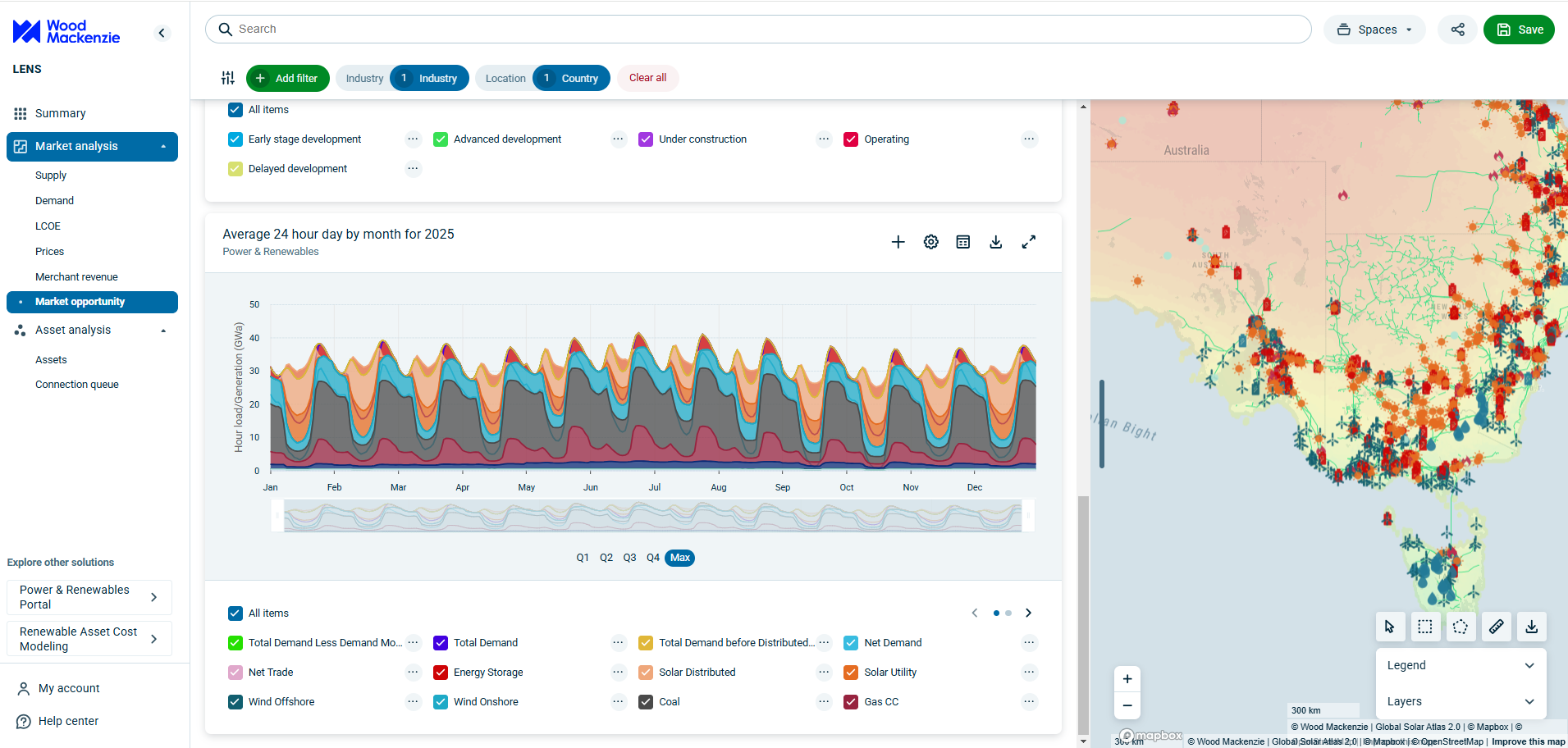Discuss your challenges with our solutions experts
A year in review of behind the Meter Solar: Unmasking the secret solar in California
1 minute read
Authors: Adrienne Horne, Project Manager and Eldon Lopes, Meteorologist
Motivation
The California Independent System Operator (CAISO) market saw more hours with energy prices below $0 in 2017 than any year since 2012, continuing a trend seen in recent years. The ongoing influx of solar generation in the region is the main catalyst for more frequent negative pricing during midday hours. While impacts due to utility-scale solar build-out in CAISO get the most headlines, behind-the-meter solar (BTM) growth is worth a closer look. Installed CAISO BTM capacity climbed from under 1,000 MW in early 2012 to 6,265 MW by May 2018. While BTM capacity growth was expected, CAISO demand forecasts worsened over the last five years, specifically for daylight hours (Figure 1).
Each year, even when demand forecast error decreased during non-daylight hours, it remained highest during the midday (Figure 2), illustrating an increased complexity of evaluating the impact of BTM demand. Since BTM is only visible as decreased demand, and other factors can decrease demand in CAISO, it is difficult to estimate the magnitude of actual BTM and the resulting price volatility. While BTM models exist, they are limited by the availability of measured data and photovoltaic (PV) performance assumptions. Pairing reliable, real-time monitored BTM data with market analysis is critical to address the future challenges of CAISO's energy landscape saturated with BTM.
Background information
It took almost ten years, between 2005 to 2014, for the interconnected CAISO BTM to reach 2,000 MW (Figure 3). In less than half that time, from 2014 through early 2018, that capacity nearly tripled to above 6,200 MW. Capacity added per year remained above 1,000 MW since 2015. With increasing BTM capacity and the resulting output, CAISO demand remains weak even on peak demand days with higher temperatures.
Comparing two days with the highest demand in CAISO history illustrates how BTM is degrading demand. On 1 September 2017, parts of California experienced record-breaking temperatures, but demand was lower than 24 July 2006 (Figure 4). These are similar weather days that both came on the back of an intense heatwave, engulfing the entire state. Although some demand deterioration was due to the upcoming Labour Day holiday, the average maximum temperature on the 2017 peak day reached 104.7 °F – over 5 degrees warmer than the 2006 peak day with an average maximum temperature of 99.6 °F (Table 1). Additionally, cooling degree days were 1.4-degree days greater on the 2017 peak day than the 2006 peak day. Given the difference in degree days, weather conditions alone would have caused higher peak demand in 2017 without BTM impacts.
The impact of BTM on the demand curve is evident during hour 17 PT on 1 September 2017, when actual demand reached a high of 49,909 MW (Figure 5). Since BTM output is visible in the market as decreased demand, the effective demand without BTM output is visualised by adding BTM output to actual demand. This shows that demand would have reached 51,655 MW if BTM had not met some of the demand during daylight hours (Figure 5). With BTM reaching almost 3% of actual demand that hour, the peak demand decreased by over 1 GW.
In their March 2017 market report, CAISO described how negative prices in the real-time and fifteen-minute markets increased (Table 2). The frequency of negative prices from 06:00 to 22:00 PT (on-peak) has been increasing since 2013, with the highest concentration shifting into daylight hours (Figure 6). The number of hours with negative on-peak prices surged significantly in 2017 due to strong hydro generation. As of July 2018, there are 140 hours with negative on-peak prices. Despite a decrease in hydro generation from 2017, negative prices remain prominent and are more frequent than in 2013 and 2014.
Summary of findings
Wood Mackenzie and subsidiary Locus Energy combined their proprietary energy monitoring networks and market insight to provide measurements of BTM and analysis of market impacts. While the market is struggling to understand the magnitude of BTM – with increasing demand forecasting error and rising frequency of negative real-time prices during daylight hours – Wood Mackenzie analysts leverage Locus monitored BTM data to improve demand and price forecasts.
What happens on a surprise, cloudy day?
On 6 April 2017, cloud cover and rain were more intense than expected across Northern and Central California. The actual demand came in at an hourly average of nearly 500 MW higher than the CAISO forecast during daylight hours (08:00 to 15:00 PT) (Figure 7). Hourly actual demand was 700 MW higher on average than the Day Ahead Market (DAM) cleared demand across daylight hours. This mismatch between actual and cleared demand, and the CAISO forecast indicates CAISO and market participants underestimated the magnitude of BTM.
BTM decreased by an hourly average of 800 MW compared to the previous day for daylight hours and over 1 GW at its peak (Figure 8). Since cloud cover settled in at a lower elevation than expected, limiting sunlight in areas of concentrated BTM installations, the dramatic drop in BTM output was unexpected and contributed to price volatility. Looking at the actual BTM output, it would have been clear during early morning that BTM would come in well below the previous day; but since the market did not adjust for this, real-time prices came in higher than day-ahead prices only during daylight hours.
What happens when the sun shines unexpectedly?
On 23 March 2017, morning cloud cover dissipated more quickly than expected, and actual demand came in at an average 330 MW below the CAISO forecast across daylight hours. This caused negative real-time prices to come in below the day ahead price throughout the middle of the day (Figure 9). While utility-scale solar generation was over 300 MW weaker than forecasted, likely due to curtailments, BTM output came in over 1.1 GW higher than the previous day at its peak and contributed to the demand forecast error and resulting price volatility (Figure 10).
Analysis methods
Wood Mackenzie subsidiary Locus Energy is a monitoring and data analytics platform for distributed PV solar. It monitors 8% of total installed BTM capacity in CAISO – close to 500 MW - with a monitor distribution representative of the total installed capacity (Figure 11 and Figure 12). Their proprietary monitoring technology is used by commercial, residential, and utility asset owners to monitor site performance. Anonymised aggregations of this data are available for analysis and accessible via API to allow for simple integration of near real-time BTM output into most analysis methods. Using Locus BTM data gives Wood Mackenzie Power Market Analysts a clearer picture of the impact growing BTM capacity has on demand forecasts and prices.
Outlook and conclusions
The 1,117 MW of BTM solar capacity installed during 2017 outpaced the 664 MW of utility-scale installed capacity for the first time since 2011. Annual growth of installed BTM capacity is not looking to slow down any time soon either, as 2018 has seen the second most installed capacity with already 471 MW through May. CAISO estimates BTM growth will follow a near-linear trend across the next five years, with over 7,500 MW installed by the end of 2018 (Figure 13). The 2018 estimate is on the higher end, considering installed capacity through May 2018 sits at 6,265 MW with an average monthly increase of around 90 MW this year. Beyond 2018, the 1,200-1,300 MW projected annual installation is attainable based on recent growth. There is reason to think this number is conservative. In addition to increasing affordability and accessibility of PV technology itself, other new technologies, changing market mechanisms, and upcoming policy updates all stand to boost BTM build-out.
Battery storage and smart metering technologies stand to change the impact of BTM on the market going forward and are important in future analysis. Battery storage could allow excess BTM output to be shifted to hours with higher demand, and smart metering could enable better overall integration with the grid, increasing reliability and stabilising energy costs.
A new market mechanism introduced in 2014, the Energy Imbalance Market (EIM), allows excess generation export to balancing authorities outside of CAISO. EIM allows for increased reliability without curtailing solar or wind or turning off thermal generating units within the states by providing more avenues for excess generation. This is a temporary way of mitigating risks from forecasting error since BTM capacity is expected to grow in other regions and contribute to excess generation while taking away opportunities to export BTM. Even with EIM in place, the market is experiencing a rising frequency of negative prices.
In terms of policy, California is set to require new homes to be built with solar panels starting in 2020. According to California Energy Commission estimates about 117,000 single-family homes and 48,000 multi-family units will be built in 2020 alone. Wood Mackenzie analysis indicates the average non-utility installation in CAISO is 8.3 kilowatts (kW) in size. If an 8.3 kW installation is installed on each single-family and multi-family home in 2020, totalling 165,000 homes/units, annual capacity added in that year would total roughly 1,361 MW. This number demonstrates the potential for far greater annual BTM solar capacity additions than the CAISO estimate after 2019 (Figure 13). The increase in installed BTM capacity suggests continued market impacts through 2022 and beyond.
California regulators are attempting to help manage higher penetration of distributed resources on the grid through modifications to the California Public Utility Commission’s Rule 21 (Rulemaking R.11-09-011). The most significant change is the phased-in incorporation of advanced smart inverter technical capabilities. The initial phases of Rule 21 allow PV systems and batteries to remain connected to the grid during voltage disruptions through voltage optimisation controls. Previously, systems would simply disconnect, which could potentially further destabilise the grid. The next phase, which will be implemented in 2019, will require remote communication capabilities, allowing grid operators to remotely adjust the operation of distributed resources and gain more insight into BTM production.
Wood Mackenzie is preparing for expected technology, policy, and market changes by analysing BTM volatility trends and corresponding real-time price impacts. Exclusive visibility into the magnitude of BTM from Locus data combined with Wood Mackenzie analysis of market conditions provides unparalleled insight into the relationship between BTM and market behaviour. Contact us to learn more about trends in CAISO negative real-time prices due to BTM and forecasts for future volatility.




















